YOGA TAICHI 91
Alliance harmonieuse du Taichi chuan , du Qiqong , Yoga et de la Méditation

YOGA TAICHI 91
Christian RASOTTO
1 Bd de BRETAGNE
91160 LONGJUMEAU
06 17 08 68 09
01 69 09 42 67
shanti91160@gmail.com
Sticky hands: the Tuishou
Tui Shou can grasp the concept of full and empty (yang and yin) through touch.The full-Tui Shou is equivalent to a high density or concentration, the vacuum corresponds to a relaxation or distraction.The training is to adjust the touch of a partner: if they respond with full vacuum and vice versa.In classical Chinese thought, the concept of empty and full can be found in all the arts (painting, calligraphy, music).Tui Shou also allows us to feel the continual flux of change that always occurs in reality, following the line of least resistance, like water.
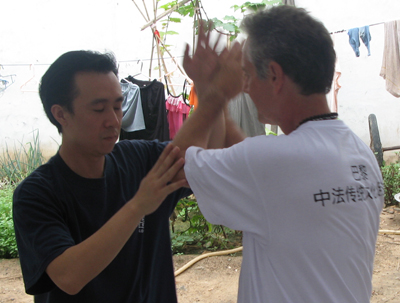
Tui Shou expands our sensory field thanks to elastic movements in all directions (up, down, front, back, circular).The body becomes sensitive and strong, allowing it to react readily.The study of Tui Shou creates the feel for all the techniques of defense and offense: parries, blocks, strikes.The implementation of the explosive force used to study the transmission of force on the partner.Tui Shou also introduces the principles of the imbalance.Tui Shou prepares for MMA because it is systematic training in the combat phase where you are in contact with the enemy.
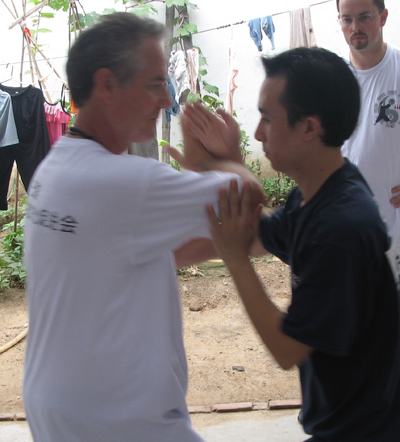
Basic exercises are making contact with one hand, on site, studying the different directions of force.We push forward, pull, deviates, one climbs, descends.Then we move on to exercises with both hands, place and displacement.We study first the direction of elastic force, then we learn the imbalances, to push and pull partner.We begin by joining the partner then paste it in its movements, connect and monitor all changes of direction.

Coaching Tui Shou is pushing with the hands is one aspect of Chinese martial arts such as Taiji Quan, Xing Yi Quan, Ba Gua Zhang, and Wing Chun.The tui shou are closely linked with fundamental notions of Chinese culture.Let us see the specificities of tui shou of Yi Quan:
1.Continuity through the spiral
2.The rupture of the spiral
3.Processing and deflection of attacks
4.The power transmission
5.Failure to act to act better
1.Continuity through the spiral
The specificity of the tui shou yi quan is the form in both hands.The forearms are touching opposite partners, closer to the wrist (see photo 1).The forearms rotate in the manner of a spiral.Both hands are directed towards the partner.Both partners do the same movement alternately.The alternation above, below, raises awareness around the forearm.Found in this gesture the symbol of Yin and Yang (perpetual change without breaking or domination).The winding is done with a touch or too empty (soft) or too full (contracted).One rule to keep in touch and feel the constant progress of the gesture.The repetition of this gesture allows a unification of feelings between the two partners.This training provides consistent feel and listen with skin changes of density and spatial changes.This move is a prelude to the break (an initiative of attacks).These movements are performed systematically by studying the spiral tui shou, on-site and on the move.

2.The rupture of the spiral
The rupture of the spiral occurs when one partner will want to attack, push, unbalanced.Phase failure is maintaining contact.Push hands can feel the rhythm changes, density (full or empty) will and will respond appropriately.Yi Quan in the initiative of attack may be at hand, two hands, hands to the center of the body generally.The attack of the hand can become elbowing and shoulder.Learning to break the spiral runs parallel to learning the power transmission and transformation of movements.To avoid being unbalanced, it must transform and deflect the attack by sticking and following.
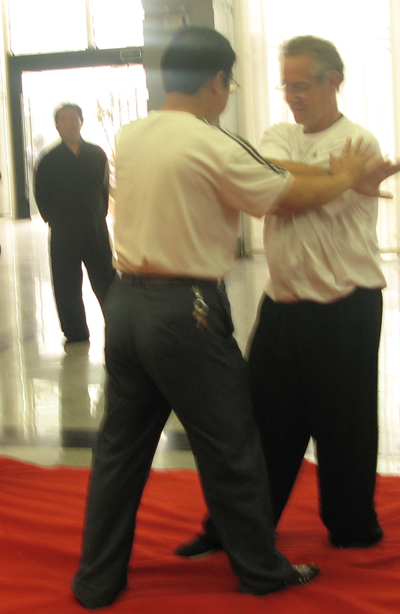
3.Processing and deflection
There are several solutions to avoid imbalance or attack:
1.Cancellation
2.Deviation
3.The transformation
4.Absorption
1.The cancellation of the initiative to attack from birth is the ideal reaction (very difficult).This is done by changing the density of the contact or direction of movement without break.The partner will follow or be stopped in its tracks.
2.It deflects when one feels an overflow in a given direction (which will create a vacuum).The deviation depends on the direction of thrust.For example, a strong push with one hand, moving the back foot by keeping in touch and left arm forward thrust in vacuum (see photo).A good grasp of the movement makes the deflection of attacks and attacks.
3.The transformation of an outbreak is due to the elasticity of the body.We keep in contact during the thrust, we change the direction of the attack (by remaining stuck), the partner may be unbalanced, it will have to follow the change.The transformation applies to any type of thrust or attack.
4.Absorption occurs when the pressure was not canceled, diverted or converted thrust.The root is the basis of absorption.In rooted to the ground, rounding up the rainbow body and is absorbed by the transmitting power to the ground.This absorption allows a return of the arc towards the opponent.In tui shou we react to the full and empty.Full documentation is too much contraction amplitude too, too much control, etc.....The empty stands for too much softness, lack of presence, lack of grounding, lack of contact.
These techniques were previously studied only through the Shili (try force).The force is not a brute force but a force winds and continues as a thread of silk stretching.
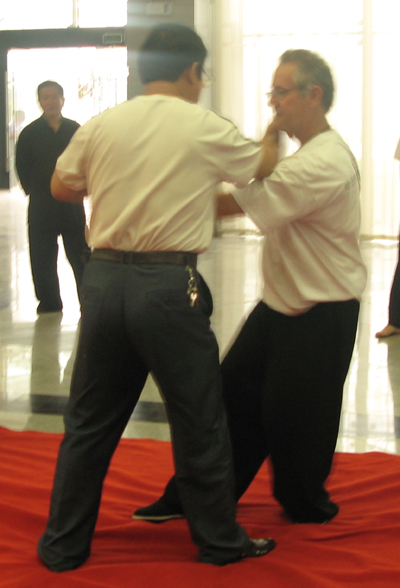
4.The power transmission
The transmission of force on the partner can:
1.The imbalance
2.Typing
3.The destabilization
Techniques for power transmission are studied yi quan through techniques of Fa-li (force that springs), in other Chinese martial arts also known as Fa-jing.Before bringing out the force, it will accumulate (soujing) through the Zhuang and Zhang Shili.
1.Fali to unbalance the use of force extension of the body.The imbalance occurs either pushing forward or pulling back, either by using the force of opposites (left / right, front / rear).The force of thrust must be like a spring (short, full, explosive).We use the strength of the body as a whole (zheng ti).
2.The fa-li used to strike the percussive force that penetrates a few centimeters.In pushing hands can not touch that body, his body-lis destabilize the partner but do not incapacitate.
3.To destabilize the Fali use a variety of forces: the act of rubbing, pressing, winding, twisting, shaking creates a vacuum that allows chaining technique for unbalance.The force shakes, for example, is a succession of F-li shook as if an olive.The F-lis are to destabilize the boundary of the imbalance and the percussion.
All these forces are created by the sensation supports the body in space and internal forces (extension, flexion, unification, opposition).The tui shou is not intended to partner K.The.but to study the various signals of strength in touch.Power transmission is essential for technical parries and attacks in the Sanshou (free fighting).
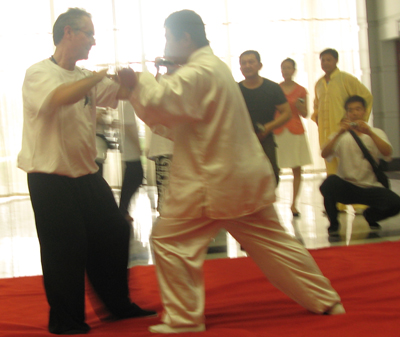
5.Non-action for better action
The pushing hands are put into practice the concept of Chinese Taoist non-action (wu wei).The spiral movement and transformation in the continuity allow its application.The spiral is a way to feel the right moment to act.The action takes place without taking any risk, it rushes like a river that flows, we follow the line of the greatest of ease.There is no will to win or dominate.Failure to act implies listening and osmosis with the interior and exterior.
This notion is active.Act-without-action is a laissez faire / laissez-passer.Ensure that the action could proceed alone.The image of the serpent or dragon describes the concept of non-action, the soft body of the dragon has no fixed form, it undulates and bends in all directions, contracts to deploy, folds for advance; he married so the clouds that still carried by them, he moves without spending
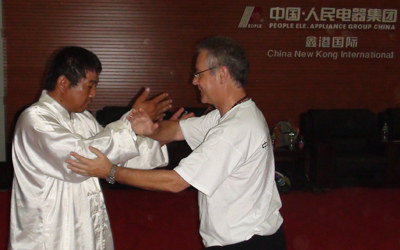
A cultural form of Chinese combat
The tui shou is a form of training to acquire technical and theoretical principles related to Chinese culture.This form of combat is not a fight for the same purpose in Western style.The tui shou is made to feel the harmony, fluidity, elasticity, transformation, explosiveness, rooting through contact and touch.Control and domination are not using brute force.
The tui shou require a long learning alone (zhan zhuang for rooting and unity, shi-li for the transformation and continuity of forces, F-li to spring forces, mocabu for travel) before their implementation two.
The tui shou is a master key to find a state of ideal body for fighting and health.The continual drive to contact promotes the availability in the phase of close combat during the Sanshou (free fighting).



